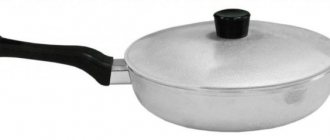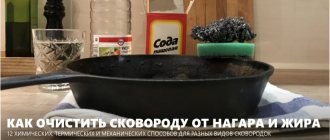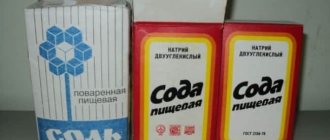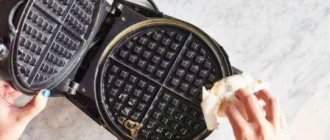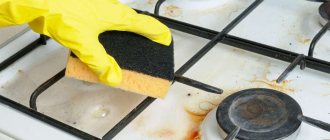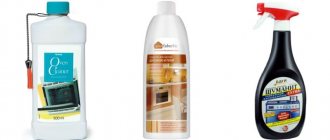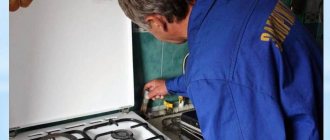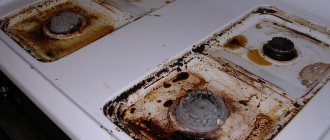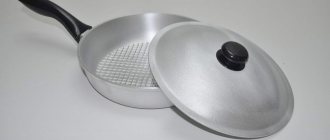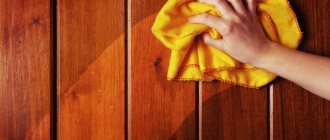Over time, any kitchenware loses not only its aesthetic appearance, but also its performance qualities. The same goes for Teflon-coated frying pans. It is these frying pans that have excellent contact with various alkaline and acidic agents, are not afraid of corrosion, and cleaning a Teflon frying pan is easy. Food does not burn, which makes it possible to cook light food. Let's look at what home remedies you can use to clean a Teflon frying pan without damaging the integrity of the coating.
How to clean the inside of a Teflon frying pan
Teflon itself is delicate and is quickly deformed by hard brushes and iron devices. Therefore, when cleaning such a frying pan, you need to arm yourself exclusively with soft sponges, rags and non-abrasive products.
It is also advisable not to use various powdered preparations. There are several excellent tools available that will quickly remove greasy deposits from a frying pan without damaging the inner surface.
Using food baking powder
At first glance, the solution may seem unexpected, but nevertheless it is effective. Baking powder, which pastry chefs add to the dough when baking baked goods, really helps clean a Teflon frying pan from grease and soot.
You need to take 4 tbsp. spoons of baking powder, dissolve in 350 ml of water. Pour the mixture into a dirty frying pan, place over medium heat and boil from the moment of boiling for 15-20 minutes, depending on the complexity of the contamination. After this, drain the solution and wash the pan with detergent and a soft sponge.
Advice! Baking powder can be replaced with regular soda. Just take a little more quantity: 5 tbsp. spoons per 1 liter of water.
How to wash with laundry soap
You can clean a Teflon frying pan in almost the same way with laundry soap. Only the soap solution does not need to be boiled, just slightly heated over low heat and left in the pan for 60 minutes to soak.
Pre-grind the soap using a grater and dissolve it in a small amount of water. After soaking, drain the water and rinse the pan with a sponge.
Clean with vinegar
To clean a Teflon frying pan, it is better to use 9 percent vinegar. Pour water into the pan to about half the volume, add 2 tbsp. spoons of vinegar.
Boil the solution over low heat for 20 minutes. Remove the pan from the heat and set aside until completely cool. Drain the mixture and rinse the container with running water and dish soap.
Cleaning the carbon deposits from the outside
In addition to ready-made detergents, other products that can be found in every home will effectively help remove carbon deposits from the outside of the frying pan.
Laundry soap
Required:
- ¼ bar of soap;
- water.
Preparation:
- Grate the soap and pour into water. Heat without letting the water boil.
- Place the pan in the solution for a couple of hours. Then wash with dishwashing detergent.
Soda
Required:
- water – 1 l;
- soda – 5 tbsp. l.
How to clean the outside of a Teflon frying pan
Cleaning the outside is much easier, since here you no longer have to worry about scratching the coating; the outside is much more resistant to various chemicals and powders.
The outside of such utensils is usually made of polished steel or aluminum and coated with enamel. You can remove greasy deposits using the following popular store-bought products:
- "Shumanit" liquid;
- "Mr. Cheester" - spray;
- "Domestos" - gel;
- "Fairy Power" - spray.
Of all the above remedies, the most effective is Schumanite. However, during the cleaning process, you must wear gloves on your hands, because its composition contains a large amount of chlorine and other ingredients harmful to the skin.
Features of frying pans with Teflon
First, let's understand the terminology. The material, known in the world as Teflon, was developed by employees of the American company. Manufacturers of tableware, as well as clothing, technical devices, and umbrellas, have the right to put the Teflon® trademark only after receiving the appropriate license.
Other non-stick coatings produced by various brands may contain polytetrafluoroethylene (PTFE) polymer, but they are not related to true Teflon.
The famous French company (Tefal) produces several series of frying pans with non-stick coating (Jamie Oliver Hard Anodised, Preference, Evidence). The number of layers varies, from 4 to 6, PTFE is present, and a patent has been received for the coating.
In everyday life, out of ignorance, consumers continue to refer to Teflon cookware with multi-layer non-stick coatings from a variety of brands. There are similarities, but real Teflon®, although capricious in terms of cleaning, is durable.
How to quickly clean a Teflon frying pan
If you don’t have time to clean the Teflon frying pan inside and out, you can use methods that wash off fat and carbon deposits at the same time - by soaking in soft solutions. It’s not difficult to prepare them; you need fairly simple ingredients that are always available at home.
Activated carbon cleaning
You will need up to 20 tablets. First, use a rolling pin to turn it into powder, add 1 glass of water to make a mushy mass. Grease the entire pan and set aside for a quarter of an hour.
After this time, place the container in a wide basin, fill it completely with water, add a few drops of dish soap and leave for 45 minutes. Drain the dirty water from the container and rinse the pan with a sponge under running water.
How to clean a Teflon frying pan with mustard powder
You can also wash a Teflon frying pan with regular mustard. Apply the bulk ingredient with a sponge to the inner and outer surfaces of the frying pan and leave for half an hour. Rinse thoroughly with running water and detergent.
Toothpaste
In the same way as with the previous component, apply to all surfaces of the frying pan, leave for half an hour and rinse thoroughly with running water and a sponge.
Preventing carbon deposits
In order for kitchen utensils to serve for a long time and not become covered with soot, several rules must be followed . The frying pan is not heated to a temperature above +230°C. After such a thermal shock, the dishes will not only become covered with carbon deposits, but will also lose their protective Teflon layer.
Do not heat dishes without oil or leave them on the fire unattended . In the first case, the dishes are deformed and may even catch fire; in the second, the food will burn. Do not put too many foods into the dishes, especially fatty meats. If the layer is higher than the sides of the pan, the fat will flow down the outer walls.
Rules for using a Teflon-coated frying pan
To prevent premature wear of the coating on the frying pan, you need to know the basic operating rules:
- The pan must be washed immediately after use.
- When mixing products, use exclusively plastic or silicone spatulas and spoons.
- After cooking, do not immediately lower the pan into cold water - the coating will quickly deform due to sudden temperature changes.
- You cannot cut the dish directly in the frying pan.
- Do not wash the pan in the dishwasher.
- Do not fry foods at high temperatures.
- Do not heat a dry frying pan without oil.
- Do not use strong detergents such as Schumanite to clean the inside of the pan.
Remember! If the Teflon layer of a frying pan is damaged or worn out, it cannot be used for cooking. The food will burn, and particles of Teflon, which is dangerous for the human body, will get into the dish.
Types of contamination on non-stick coating
Nonstick pans produce several types of contaminants .
External pollution:
- carbon deposits from exposure to open fire appear on frying pans that are used on gas stoves;
- baked fat that runs down the sides of the dish.
Internal pollution:
- baked fat that sticks to the pan if the non-stick coating is damaged;
- carbon deposits from heating a frying pan without oil.
It can be useful:
How to clean ceramic frying pans from grease and carbon deposits
How to clean a cast iron frying pan from carbon deposits and rust
How to clean a cauldron from carbon deposits
What not to use to clean non-stick surfaces
To ensure that the anti-burn properties are preserved for a long time, choose delicate cleaning methods. Avoid using formulations that contain large amounts of acid or alkali. Together with the fat, they will also corrode the coating. Avoid hard brushes and sponges, as well as products with abrasive particles. They may leave scratches.
If trouble occurs and the protective layer is damaged, follow the procedure to restore it. Using a brush, lubricate a clean, dry product with vegetable oil (on all sides). Try not to miss a single millimeter. Then place the pan in an oven preheated to 200 °C for 60-120 minutes. After the specified time has passed, turn off the appliance. Do not remove the dishes until they have cooled down. The resulting protection will prevent rust and food from sticking. If this does not help, you should get rid of the dishes.
Methods for cleaning dishes from the outer surface
It is easier to clean the outside of a Teflon-coated frying pan than the inside, since it is more resistant to the external effects of aggressive chemical agents. As a rule, it is polished steel or aluminum coated with special enamel. You can deal with soot and traces of old burning using the following industrial products:
- liquid product Shumanit;
- Mister-Chister spray;
- Domestos cream-gel;
- Fairy Power spray.
The most effective of them, of course, is Schumanite. But when working with such products, it is imperative to use rubber gloves to protect the skin from the aggressive action of the active substances.
You can also use a mixture of baking soda and 3% hydrogen peroxide. For 3 tablespoons of baking soda, take 5 tablespoons of peroxide and mix thoroughly. Apply a thick layer of the mixture to the dirty walls of the frying pan, leave for 3-5 minutes, then scrub with an abrasive sponge. Soot and dirt are cleaned off quickly and easily.
72% to help
Laundry soap is not inferior to soda in popularity among housewives who prefer environmentally friendly methods of washing, cleaning, bleaching and washing dishes.
To clean Teflon frying pans, 72% soap in the form of shavings is used; a quarter of a piece is enough to clean one frying pan.
You can boil Teflon in a soap solution, but you need to do this for at least 40 minutes. The time can be reduced if you combine the two described methods - take soap shavings and baking soda in equal parts. The product will be universal. Removes almost any contaminant not only from Teflon, but also from any other surfaces.
Important! Do not boil Teflon frying pan lids with plastic handles in a soap and soda solution; they will deteriorate.
Soap-soda complex is the most effective and safe means for many types of cleaning. Experienced housewives use it all the time, because good results are achieved at a very affordable cost.
Household chemicals
It is not difficult to find chemicals for cleaning Teflon in the hardware department; it is more difficult to understand the assortment. Here the issue is decided depending on your financial capabilities - buy what is available to you. It’s up to you to decide whether to buy the expensive Sif gel or the domestic Organix. Any brand of chemicals has the disadvantage that they are unsafe for health, but you are still going to clean food utensils.
So maybe folk remedies for cleaning Teflon are still better? It is, of course, up to you to decide. When purchasing any product, do not forget about a special sponge for non-stick cookware - you should always have this item.
Chemicals should be used in strict accordance with the manufacturer's recommendations.
Other, no less effective ways
Why not try something different, something original:
- We clean using such a popular drink as Coca-Cola. Pour it into the pan and boil for 10-15 minutes. How it works? It’s just that the same soda, which is part of the drink, does the cleaning.
- Let's use toothpaste. Why not? After all, she is always at hand. Distribute the paste in an even layer over the contaminated surface, and after half an hour, wash everything off.
- Ethyl alcohol is also suitable, since it will only take a few minutes to deal with such a nuisance as carbon deposits.
Store-bought cleaning products
If negative consequences of ironing occur, first of all, there is no need to panic. Because with the right approach, you can efficiently remove even the oldest marks. The procedure will take a little longer, but you won’t have to spend money on a new device.
The non-stick coating is quite easy to remove stains if you choose the right product. Usually it is selected depending on the type of pollution.
11 ideas on how to clean a Teflon-coated iron from dirt.
- Acetone. Cleans particles of burnt fabric and melted polyethylene well:
- First, moisten a piece of cotton wool with acetone;
- apply the product to the area with soot;
- After 2-3 minutes, use the same cotton wool to remove the dirt.
When cleaning, the soleplate of the iron must be cold. Instead of acetone, you can use nail polish remover.
- Hydroperite. Effectively cleans the iron from carbon deposits of any complexity:
- heat the surface to maximum;
- run a hydroperite tablet over it (active gas release should occur);
- remove particles of the tablet along with contamination with a damp cloth;
- then wipe the Teflon sole dry with a soft cloth.
It is better to do the procedure with open windows or on the balcony, because when reacting with hydroperite, a pungent odor is released.
- Toothpaste. This product is often used to clean various surfaces. Therefore, at home, you can also use the paste to clean the soleplate of the iron, without harming the Teflon coating:
- Apply a thin layer of toothpaste to the warm surface and rub well;
- then clean it with a damp cloth.
- Lemon acid. Allows you to successfully remove scale from Teflon surfaces:
- Dilute 2 teaspoons of acid granules in 0.5 cups of hot water;
- put on rubber gloves and moisten a cloth with this solution;
- carefully wipe the entire sole with it, simultaneously freeing each hole from scale;
- To clean heavily soiled holes in the Teflon sole, you can use cotton swabs.
- Chalk. Quite an unusual but effective remedy for soot:
- We heat the device, take chalk and move it along the sole. In this case, all contaminants roll off the surface;
- then wipe the Teflon coating clean with a napkin.
- Ammonia. Allows you to get a noticeable cleansing effect:
- moisten a piece of cloth with ammonia and apply the liquid to the sole;
- In case of heavy dirt, heat the iron and iron the dampened cloth.
When using this method, you must take care to ventilate the room.
- Paraffin candle. Most often used to clean the soleplate of the iron from fresh marks:
- wrap the paraffin candle with a soft cloth;
- wipe the hot surface with it;
- then remove any remaining dirt with a clean napkin.
- Dish or window cleaner. Another inexpensive but effective method for cleaning an iron from remnants of burnt fabric:
- First we heat the device;
- then moisten a soft cloth with the product and apply it to the Teflon surface;
- at the end we clean it with dry cloth.
- Vinegar. Perfectly removes any traces on Teflon surfaces. The application scheme is as follows:
- moisten a piece of cotton wool with vinegar;
- wipe all contaminated areas;
- Use cotton swabs to clean each hole in the covering;
- heat the device and iron the cotton fabric.
- Laundry soap. A very common way to remove carbon deposits:
- Wipe the hot sole with a bar of soap;
- After the device has cooled slightly, remove the residue with a damp cloth.
- Cleaning pencil. Probably all housewives know about this magical remedy that helps clean the dirty surface of the iron. But some people don't know how to use it. The pencil should be used in this way:
- Place the device vertically, turn it on and heat it to maximum;
- then turn it off and gently rub it with a pencil;
- wait until the surface cools down and clean it with a cloth.
This procedure can be performed 2-3 times until the Teflon sole is impeccably clean. If there is an unpleasant odor, do not worry, this is a normal reaction of the pencil melting.
Before starting to use folk remedies with which you can bring your “darling” into the proper sparkling form, let’s try to do this using ready-made formulations purchased from a retail chain. Here is a small list of drugs offered:
- very active product – Unicum Bami GOLD series (do not use for cleaning aluminum surfaces);
- quite effective, but for some reason rarely used - “Aromika anti-nagar”;
- a product that works gently but surely, as it removes the most stubborn dirt - Magic Power;
- but chemical compositions (sprays) for household use are on a completely different level, cleaning absolutely any surface: Fairy Power, Kiilto, “Mr. Muscle”;
- It turns out that gels and creams are also capable of such a job (it is enough to lubricate the surface with a thin layer and wash off after half an hour) - “Sanita”, “Antinagar”, “Domestos”;
- although it is foam, it can also remove everything unnecessary - Amway Dish.
What to remember when working with such tools:
- We work only with rubber gloves.
- Before work, carefully examine the kitchen utensils. Only after making sure that there are no scratches or other damage on it, we begin cleaning. The fact is that any microcrack poses a danger to your health (through it the chemical composition penetrates into the product).
- We refuse to use hard sponges and metal meshes.
We suggest you read: How to clean grout on bathroom tiles
Important! Despite the fact that store-bought formulations are very effective, they cope with the assigned tasks quite quickly, and you don’t spend much time on the whole process, they have one huge disadvantage that cannot be ignored. All utensils cleaned with chemicals are unsafe for further use. Remember this.
